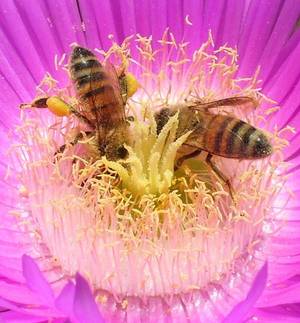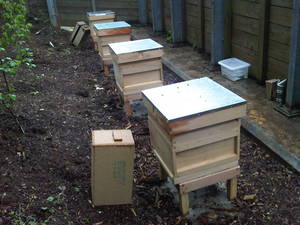Urban Beekeeping
Interview with
Helen - Another insect famous for its colonial behaviour is the honeybee, and the keeping of these bees, otherwise known as apiculture, by members of the general public has grown dramatically in recent years with the British Beekeepers' Association seeing a 40% increase in memberships over the last year. But more interestingly, the number of people keep bees in our cities has also gone up 5-fold from 30 to 150 people joining the London Beekeepers' Association in the last four years. We sent Meera Senthilingam to find just what the buzz is about.
Meera - The honeybee plays a vital role in the pollination of our crops and our wild flowers, as well as producing delicious honey. But it's well-known that their population is in decline. One way to help the situation is to keep bees yourself, something that, in the past, was thought to be confined to the countryside. But now, the field of urban beekeeping is increasingly growing in popularity. To find out more, I've come along to Camley Street Nature Park in London where beekeeping company Urban Bees are currently running a course on keeping bees in an urban environment. With me is one of the co-founders of Urban Bees, Alison Benjamin.
 Alison - A hive is made up of three different types of bees. There's predominantly the worker bee which is a female honeybee. There's about 50,000 of them at the height of the summer. Then there's the queen, again - female, and her job very much is to lay eggs. And there are the drones, a few hundred drones or the male bees who don't do very much at all apart from impregnate a virgin queen. Actually, at the end of the summer, the worker bees chuck them out of the hive. You have to think of a bee colony as a super-organism. So, in the way that we're made up of cells, a bee colony is made up of bees. The queen isn't actually in control of the beehive. She is very much a slave to the colony.
Alison - A hive is made up of three different types of bees. There's predominantly the worker bee which is a female honeybee. There's about 50,000 of them at the height of the summer. Then there's the queen, again - female, and her job very much is to lay eggs. And there are the drones, a few hundred drones or the male bees who don't do very much at all apart from impregnate a virgin queen. Actually, at the end of the summer, the worker bees chuck them out of the hive. You have to think of a bee colony as a super-organism. So, in the way that we're made up of cells, a bee colony is made up of bees. The queen isn't actually in control of the beehive. She is very much a slave to the colony.
Meera - So you have the three different types, but within that, there are specialised roles for them within their colonies.
Alison - When the bees are first born, they come out and their sting isn't developed, their various glands to make wax aren't developed, so they do special duties in the hive like cleaning the cells out so the queen can lay another egg in that cell. They might be feeding the queen, or cleaning the queen. They'll be spending about 3 weeks in the hive and as they grown older, probably for the last of that week, they'll be guard bees, so they'll be at the entrance of the hive making sure that bumble bees or other creatures don't stray in, or keeping wasps away. And then they'll spend 3 weeks out foraging for nectar.
Meera - What about the structure of the hive itself? So we're here at the Camley Street Nature Centre. There are four hives here. They're about 2 foot square. They're just a box shape really. Unfortunately, it is pouring down with rain, so there are no bees out and about, they're all inside, but how, if I was to be able to see inside this hive, would it be structured?
Alison - If you take the lid off, what you'd see is what's called the brood box which is where the queen, her workers and the babies live, and they live on honeycomb. So you will have 11 frames of honeycomb.
Meera - And these are basically just flat sheets.
Alison - Yes, they're flat sheets of wax that we actually give the bees. They draw out this flat comb, so it becomes 3D, and then they use that as chambers in which the queen will lay eggs, in which the larvae will develop and in which they'll store their honey and their pollen.
Meera - So once the bees are here, the hive is here, so what then happens when the bees are sent out and about? What are they foraging for? What are they bringing back?
 Alison - Well the bees are basically going out to get as much nectar and pollen as they can to feed the larvae that are developing in the hive. Basically, they're attracted to the flowers by the nectar that the flowers are producing. When they go to collect the nectar, they then inadvertently pollinate the plants. As well as bringing back the nectar to the hive which is their carbohydrate, the energy to feed the babies and themselves, they're also bringing back pollen which is the protein that they'll feed the larvae. Each bee will survive for about 6 weeks during the summer, so they need to replenish the dying bees.
Alison - Well the bees are basically going out to get as much nectar and pollen as they can to feed the larvae that are developing in the hive. Basically, they're attracted to the flowers by the nectar that the flowers are producing. When they go to collect the nectar, they then inadvertently pollinate the plants. As well as bringing back the nectar to the hive which is their carbohydrate, the energy to feed the babies and themselves, they're also bringing back pollen which is the protein that they'll feed the larvae. Each bee will survive for about 6 weeks during the summer, so they need to replenish the dying bees.
Meera - What's the life cycle of these different bees and what happens over winter then when they're not out collecting?
Alison - They survive about 6 weeks in summer because it's said that they fly for about 500 miles before they're completely exhausted and die on the wing. So, if they're not out, in the winter, they tend to huddle inside the hive to keep warm, and only come out on warm days. So they can survive October through to April really during the winter, but there's only about 10,000 of them during the winter, compared to about 50,000 in the summer.
Meera - So, only a fifth of them really are left to keep the hive going over winter?
Alison - Yes, that's right.
Meera - You now specialise in producing these hives in an urban environment. We are truly in an urban environment now. There are trains going past, there are motorcycles on the road just outside the park, but what do you need to consider when adapting all of this to an urban environment?
Alison - You do have to consider whether you've got enough space if you were then to keep them in your back garden or on your roof terrace. It's not just the hive itself, which is about 2 foot square. There's quite a lot of paraphernalia that goes with beekeeping. The suit, the extra boxes because the hive grows throughout the summer when you're giving them boxes for the honey. Obviously, you need to be aware of neighbours.
Meera - On average, how much honey does a typical hive produce? As there might be lots of people that do tend to keep bees, who wanted to do so for the honey.
Alison - It's a variety of reasons actually. Some people do it just because the bees are in trouble. Environmentally, they just like the idea of keeping a creature that's out there pollinating, but obviously, some people do keep it for the honey as well, and an average hive can make about 40 pounds of honey throughout the summer.
Meera - And would you say there's much of a difference keeping them in an urban environment?
Alison - People do say that the honey in urban environments now is better than honey from the countryside because there's such a rich diversity of flowers and plants in the parks, in people's gardens, just along tree-lined roads and railway sidings. Whereas in the countryside, you may have acres of land that's planted with just one crop. Also, that isn't a very good diet for your bee if they're just surviving on one crop, so they can suffer from malnutrition where they tend to be quite strong in the cities.










Comments
Add a comment